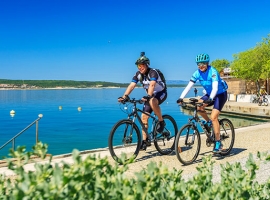History

Different rulers, cultures and civilisations have written the history of the Crikvenica area. Each segment of its rich tangible and intangible heritage has left its traces in the development of the area and contributed to what’s on offer today. These traces are visible in the remnants of ancient settlements, burial mounds, defensive hillforts, weapons, jewellery, ceramics and the specific shape of amphorae, while the intangible heritage is immortalised in barbarian curses, Pauline prayers, and the laughter and songs of local fishermen.
The history of Crikvenica, Dramalj, Jadranovo and Selce is connected to the development of the nearby medieval towns of Drivenik, Grižane and Bribir, and the fertile valley of Vinodol. Back in the middle ages, each town used to have a harbour around which fishing villages emerged. This was home to skilled fishermen and masons who shaped the life and appearance of these towns.
The sea and the opportunities it offers has steered the Crikvenica Riviera in another direction – the direction of social well-being and the development brought by tourism, one of the most important industries that started emerging here at the end of the 19th century.
CRIKVENICA
The Frankopan noble family
Before the settlement of the present-day area of the town of Crikvenica, local people used to live in the hinterland, whose centre was Kotor, which was located on a nearby hill. They engaged in agriculture, livestock breeding, and fishing; they also learned from the Roman population how to cultivate vines.
The founder of Crikvenica was Prince Nikola IV Frankopan. He had a monastery built next to the then abandoned small Church of the Assumption of the Blessed Virgin Mary and gave it to the Pauline monks on 14 August 1412. The deed of gift, which was issued in Modruš, is the oldest written document that mentions the name of Crikvenica.
Major settlement of the area of the present-day town of Crikvenica started in the 17th century, especially in 1776 when most of Kotor burned down in a fire. The parish Church of St. Simon was also destroyed, so the seat of the parish was moved to Crikvenica. Due to a lack of arable land, local people focused more on the sea and soon gained a reputation as the best fishermen in the northern Adriatic.
In the late 19th century, Crikvenica was part of the Austro-Hungarian Monarchy. After the construction of the first wooden bathing establishment on the coast in 1888, and the hotels Therapia (1895) and Miramare (1906), the town experienced an intense development in tourism, especially health tourism.
With the progress of steam shipping and maritime passenger traffic between Rijeka and Crikvenica, Crikvenica became more easily accessible and also more widely known among domestic and foreign tourists. Over time, the town has developed a tradition and obtained the status of one of the leading tourist resorts in the Adriatic, and become a favourite summer resort for many generations of visitors.
DRAMALJ
St. Helen as the patron saint
Towns emerged and developed around a local church that was located at the centre of things. This was also the case with Dramalj, which back in the 18th century was called Zagorje. After the renovation of the local church, it was renamed Sveta Jelena (St. Helen), a name which it retained until after World War Two.
The church was built on the spot of an ancient chapel, which was renovated in the Baroque style and expanded in the 18th century, when Dramalj was the chaplaincy of the parish of Belgrad. In 1796, Giuseppe Capovilla, a famous artist from Rijeka, made the marble altar for the church. The parish of St. Helen was established in 1809, and the Parish Office and Church of St. Helen were built after 1812. The interior of the church was furnished in the 19th century: the pulpit was added in 1837, and the main altar in 1845.
At first a fishing village surrounded by olive groves, Dramalj eventually transformed into a tourist resort after the construction of the first accommodation properties with the number of guests and visitors increasing over time.
JADRANOVO
History marked by fishing
The history of Jadranovo or Sveti Jakov (St. James), as it was once called, dates back to the centuries before Christ. This is indicated by the first traces of life that were discovered in this area. In the Middle Ages, Jadranovo was a coastal estate and harbour of the fortified towns in the Municipality of Drivenik, whose inhabitants later built houses around the Church of St. James and thus expanded the town. Some local people were masons, but for the most part they were fishermen who spent their time out at sea, casting their nets and fishing, mainly for tuna. A tuna observation post, known locally as tunera, still exists here as a witness of the times past. Fishing played a crucial role in the history of Jadranovo, which is reflected in the stories of local people and in the small fishing museum called ‘Kućica od ribari’ (Fisherman’s House). Fishing, masonry, and tourism have determined the past and set the future of this small coastal town.
SELCE
Goal-driven versatility
The fortified historic settlement on the hill of Sveti Juraj (St. George) largely influenced the development of present-day Selce, and the first traces of human activity in this area have been found here. The favourable position of the natural harbours and the scenic beauty of the area were appreciated by the Romans. Amphorae that have been found in the cove of Jasenova south of Selce attest to the fact that a harbour existed here back in ancient times, as well as a larger settlement whose name remains unknown.
Many items have been found from later centuries that provide evidence of how the local people lived. They cultivated vines, fished and sailed the sea, and also bred livestock. In the 13th century, Selce, as part of the Old Croatian municipality of Bribir, came into the possession of the Frankopan noble family, which had a great impact on the development of Selce as a town with a significant role in trading. There were even several sailing ships here that transported wine, oil and other goods.
The construction of the first bathing establishment in the late 19th century was followed by the opening of the first rooms for rent and also eating establishments. This was the beginning of the development of tourism, the main economic activity in this area.









